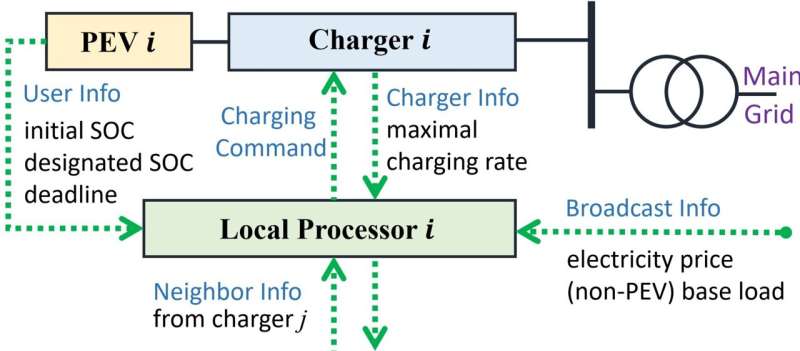This article has been reviewed according to Science X's editorial process and policies. Editors have highlighted the following attributes while ensuring the content's credibility:
fact-checked
proofread
Asynchronous distributed PEV charging protocol: Powering the future of electric vehicles

In recent years, there has been a notable increase in the adoption of plug-in electric vehicles (PEVs) on a global scale. Nevertheless, the significant surge in demand for PEV charging in particular regions or during certain periods can strain power distribution networks.
To circumvent the need for costly infrastructure expansions or renovations, it is crucial to effectively manage the charging patterns of scattered PEVs. This not only safeguards network reliability but also ensures a seamless experience for drivers, preventing any inconveniences.
To that end, a team of researchers in China has recently unveiled a new protocol designed to facilitate the coordination of PEV charging through a peer-to-peer approach. This protocol is completely decentralized, capable of withstanding asynchrony and dedicated to preserving user privacy.
It enables PEVs to derive maximum societal advantages without necessitating a central coordination hub. Notably, individual PEV owners' user-state information, including details like their location, arrival and departure times, and battery state-of-charge, remains confidential and is not disclosed to other PEV users or third parties.
"In real-life communication situations, it's normal to experience unpredictable delays, packets dropping and changes in the network structure," said Feng Liu, a professor at Tsinghua University and corresponding of the study. "The protocol offers distinct advantages over similar studies in the literature. Unlike previous studies that require collecting or exchanging individual users' charging profiles, it only requires aggregate information from a surrogate model to work."
The approach ensures the protection of sensitive user-state information and addresses the privacy concerns of PEV owners. Additionally, the protocol is established using cutting-plane consensus on the feasible region rather than traditional consensus on primal or dual decision variables. This unique approach enables the protocol to be more resilient against various forms of asynchrony that may arise in practical applications.
The team published the study in the Journal of Economy and Technology.
Notably, the study goes beyond theory and delves into practical implementation issues such as distributed initialization, distributed cutting-plane generation, and fully localized stopping criteria.
"The numerical tests conducted on IEEE 37- and IEEE 123-node feeders using actual data highlight the robust performance of the proposed charging protocol in the face of diverse forms of asynchrony, and its ability to operate in a plug-and-play mode," added Liu. "Furthermore, the quality of the solution has been rigorously confirmed through both theoretical analysis and numerical case studies."
Overall, the proposed methodology is poised to offer an alternative pathway for the resilient self-organization of PEV charging coordination, fostering the integrated progress of transportation and energy systems. Its applicability also extends to addressing other distributed coordination challenges.
More information: Yunfan Zhang et al, Asynchronous distributed charging protocol for plug-in electric vehicles, Journal of Economy and Technology (2023). DOI: 10.1016/j.ject.2023.09.002

















